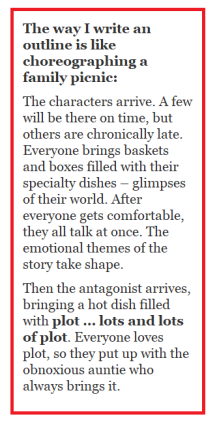Over the years, I have learned many tricks to help people get a jump on their NaNoWriMo project.
Most writers will start an entirely new story. Some have an outline, but others are flying blind, or in author speak, “pantsing it.” Other writers will continue writing the first draft of an unfinished work-in-progress.
 I am a planner, but I’m also a pantser. I’m just writing to a loose outline. All I need is a little free time in advance of November to let my mind wander.
I am a planner, but I’m also a pantser. I’m just writing to a loose outline. All I need is a little free time in advance of November to let my mind wander.
When I first began writing, I found Excel useful, but any document or spreadsheet program will work. The outline becomes my permanent stylesheet for that novel. I think of outlining as pantsing it in advance—a visual aid for winging it later.
Once I’m done winging it through the story and am in revisions, some scenes will make more sense when placed in a different order than originally planned. An outline allows me to view the arc of the story from a distance, so I can see where it might be flatlining. Perhaps an event should be cut completely as it no longer works. (I always save my outtakes in a separate file for later use.)
Over the years of editing and reviewing books, I’ve assembled a list of questions that help me nudge a novel from an idea into an outline. If I make notes as I think of things, I’ll never lose those characters or their story. Even if I can’t get to it right away, I’ll have all the essential stuff in a document and saved.
The first two questions I ask are what genre do I think I’m writing in, and what is the underlying theme? I prefer to write character-driven fantasy. A world will emerge with the characters, and I will make notes as bits and pieces of that environment occur to me. I have a deep streak of gallows humor in my personality, so humor in the face of disaster will be a theme. This theme comes out in most of my work.
 Next, I ask the creative universe who the protagonist is. I create a brief personnel file, less than 100 words. It’s a paragraph with all the essential background information. Sometimes it takes a while to know what a character’s void is (a deep emotional wound), but it will emerge. I note the verbs, adjectives, and nouns the character embodies, as those give me all the necessary information.
Next, I ask the creative universe who the protagonist is. I create a brief personnel file, less than 100 words. It’s a paragraph with all the essential background information. Sometimes it takes a while to know what a character’s void is (a deep emotional wound), but it will emerge. I note the verbs, adjectives, and nouns the character embodies, as those give me all the necessary information.
Let’s create a protagonist. He doesn’t have a story yet, but that will come along once I have a few other people figured out.
Brand (MC) (Fire-mage, armsmaster, 36, divorced. Brown hair, brown eyes, suntanned.) Parents were mages, now deceased. VOID: Deep sense of failure. A convergence of personal tragedies led to a failed suicide attempt. VERBS: Act. Fight. Build. Repair. Protect. Create. ADJECTIVES: wary, sarcastic, hopeful, dedicated, considerate. NOUNS: sorrow, guilt, purpose, compassion, wit.
Does Brand have close friends? If not, will he gather companions? This question is important. If he doesn’t have friends at first, I will leave space on that page to add them when they emerge from my imagination. As I contemplate Brand’s story, perhaps a love interest will show up later, or maybe not.
What happens to take Brand out of his comfort zone? Sometimes I don’t have the answer to this for quite a while. Other times, it’s the spark that starts the story.
The entire arc of the story rests on how I answer the following question. What is Brand’s goal, his deepest desire? Currently, it looks like he’s hoping to regain his self-respect. That will become a secondary quest when a more immediate problem presents itself.
What stands in his way? Who or what is the Enemy?
Let’s name the enemy Silas. What is his deepest desire? How does Silas control the situation at the outset? Once I know who the antagonist is and what they want, I give them the same personnel file I give all the other characters—I identify a void, verbs, adjectives, and nouns for him.
Once I have Silas described in a paragraph, I can determine the quest. Silas is the key to what Brand must achieve. A believable villain is why Brand’s story will be fun to write.
Now we come to creating the plot. I decide where the story begins, then list a few possible scenes, using keywords to show mood and intention.
 Meditating on mood words often precipitates a flash of brilliance that has nothing to do with anything. What if …
Meditating on mood words often precipitates a flash of brilliance that has nothing to do with anything. What if …
Newly arrived in the border town of Axeton, Brand discovers an ancient gate sealed with a magic lock. Beyond it, a faint path leads into the Deadlands, but where does it go? No towns exist in the moors, and no country wants to claim the Deadlands. The elemental creatures are too dangerous. Could it be a beastmaster searching for rare elemental creatures to use as weapons? If so, who has that skill, and what could they intend to do with them?
This plot twist forces me to rearrange the outline, and now I have to change Silas’s paragraph to make him a beast master. He can’t be two-dimensional, a cartoon villain, so why does he do evil with this talent? Why does he think he is the hero? The answers to those questions should give Silas a personality. We should feel some empathy for him.
How does Brand react to the pressure Silas exerts? Side characters may emerge as Brand works his way through the problems, people who will influence the plot’s direction. As the outline evolves, I will see many places where the struggle can deepen the relationships between the protagonist and their cohorts/romantic interests.
Later, after I have the characters figured out, I will work on the plot outline and try to shape the story’s arc. This is where roadblocks and obstacles do the heavy lifting, and my outline will contain ideas I can riff on. Brand will have to work hard to achieve his goal, but so will Silas.
Information and the lack of it drive the plot. Brand can’t have all the information. Silas must have more answers than Brand and be ruthless in using that knowledge to achieve his goal. My outline will tell me when it’s time to dole out information. What complications arise from Brand’s lack of information? My outline will offer hints for what he can do to rescue the situation.
With each chapter, Brand and his companions acquire the necessary information, but each answer leads to more questions. Conflicts occur when Silas sets traps, and by surviving those encounters, Brand gains more information about Silas’s capabilities. He must persevere and use that knowledge to win the final battle.
I could actually use this example as the genesis of a story, but I have a different outline in progress. Having my characters in place and an outline on hand helps keep me on track when I am pantsing it through NaNoWriMo. New flashes of brilliance will occur as I am writing, and hopefully they will make the struggle real. But two fundamental things will remain constant:
Brand’s determination to block Silas and wreck the enemy’s plans is the plot.
Brand’s growth as a character as he works his way through the plot is the story.








Looks like you’re going to have a productive November. Good luck.
LikeLiked by 1 person
Hellon Dan! I do feel good about my project. Some years I just end up with a lot of short stories and poems, but if I can figure out a logical plot arc, I think this year will be a novel.
LikeLiked by 1 person
Wishing you all the best!
LikeLike
This is brilliant, Connie. An amazing take on plotting and pantsting. I will definitely try this.
LikeLiked by 1 person
Hello! I hope it works for you!
LikeLiked by 1 person
I suspect that I’ve done this subconsciously. I usually have an idea in my head, but not written down. I know the characters, (mostly), and the beginning and end, but keep it all in my mind. What I do have written is stuff about the world my characters inhabit. The climate, the geology, the topography etc.
LikeLiked by 1 person
That’s a good point. I used to be able to keep a lot in my head, but not anymore, lol! I think that when we write notes on worldbuilding we are also firming-up the story. At least, that’s how my creative mind works.
LikeLiked by 1 person
I guess outlining is pantsing in advance, but I think of pantsing as writing completely by what I instinctively want on the page without any forethought. It did it with my first novel. Since then, I find myself constructing outlines before digging in, I don’t seem to be as productive.
LikeLiked by 1 person
Everyone’s creativity flows in a different way, my friend. I need to have a skeleton of the story, like a connect-the-dots picture. Otherwise, I end up all over the place. But many great authors write brilliant stuff as it falls from their heads, and I admire them greatly! The best advice I was ever given was from thriller author, Robert Dugoni. He said to “write the way that works best for you.” 😀
LikeLiked by 1 person
Reblogged this on Chris The Story Reading Ape's Blog.
LikeLiked by 1 person
❤ Thank you my friend!
LikeLiked by 1 person
Love the title – it’s so true! I’ve taken to using a “loose outline” myself, especially with a series. Otherwise, I can end up writing myself into a plot corner down the road and spend a ton of time fixing the manuscript. Nonetheless, I will always be a proud pantser! Thanks for a great post.
LikeLiked by 1 person
Hello! Thank you for stopping by, and for the kind words. 😀
LikeLike
Love your process. Thanks for the reminder it’s about that time again to get some kind of plan in place. This will be my third year in a row of NaNo!
LikeLiked by 1 person
Hello! I’m so glad you found something useful here. I hope it helps you to the finish line in November. 😀
LikeLiked by 1 person
Reblogged this on Kim's Musings.
LikeLike
Thank you for the reblog, Kim ❤
LikeLike